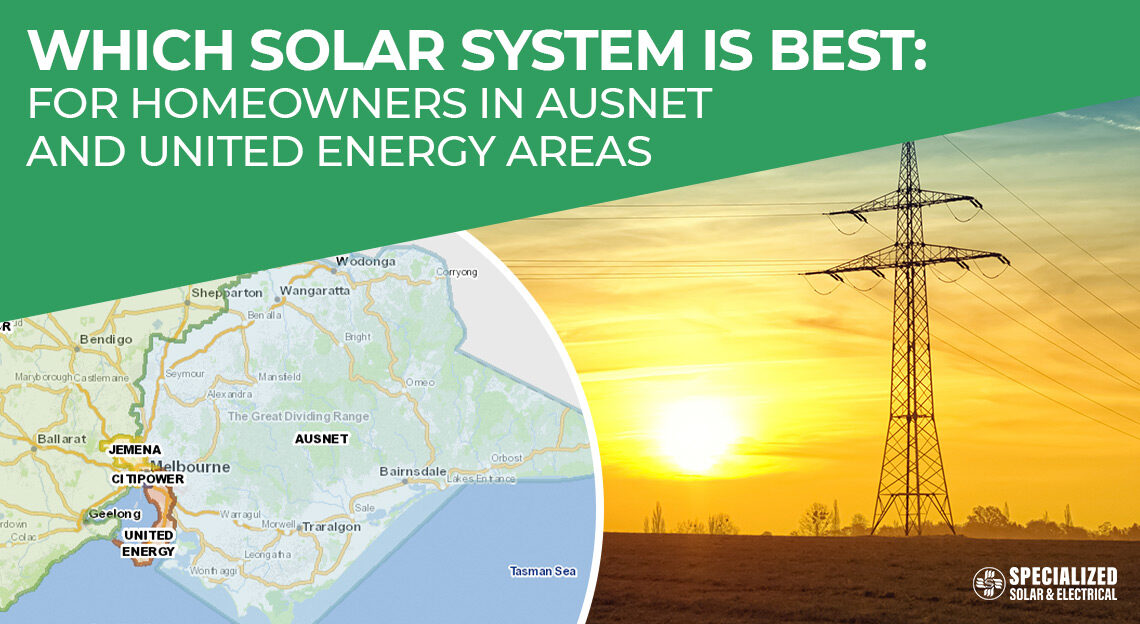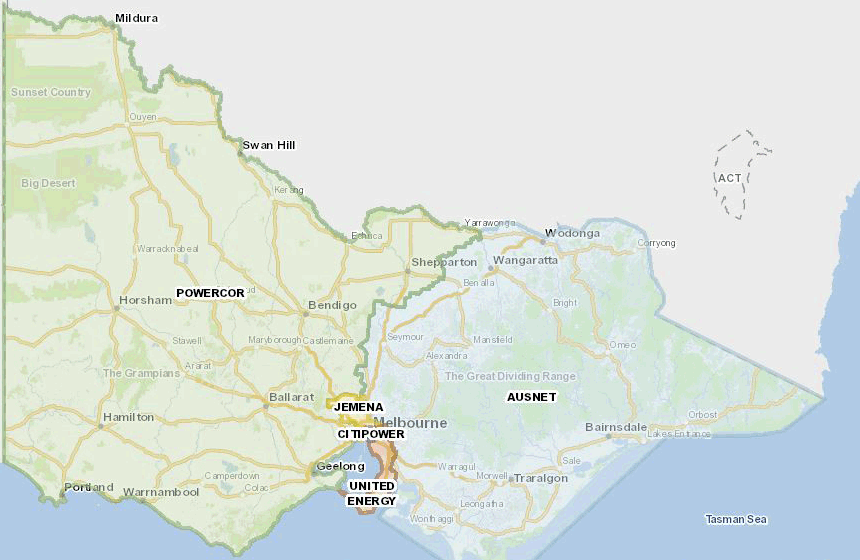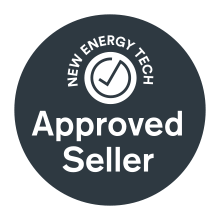A question we are often asked is: “Which is the best solar system: SolarEdge or Enphase?”.
This is a tough question to answer as both SolarEdge and Enphase are amongst the best solar power systems on the market as they optimise solar production at individual panel level (something conventional solar systems aren’t capable of).
But for homeowners living in areas serviced by the network distributors AusNet, United Energy or Jemena, there are distinct advantages that SolarEdge provides over Enphase. This is because of the specific rules set by these network distributors which affect the size system you are allowed as well as whether you can add more panels and a battery down the track.
In a world where future-proofing is important, knowing that your solar system is easily expandable is vital. You want choices and options. An electric car, battery storage, more electric appliances, even an all-electric home – who knows what the future may bring for your household?
It’s all about providing you with options; not locking you into a technology that’s limiting in any way.
That’s where SolarEdge has the edge over Enphase. And that’s what we’ll be explaining in this blog.
On this blog:
- What areas are covered by AusNet, United Energy and Jemena?
- What’s the major rule affecting solar owners in AusNet, United Energy and Jemena areas?
- What does this rule mean?
- How to sidestep this rule?
- How is this relevant if I just want solar panels?
- Why SolarEdge is ideal for households in AusNet, United Energy and Jemena areas
- Differences in technology between SolarEdge and Enphase
- Pros and cons of SolarEdge vs Enphase
- Safety comparison: SolarEdge vs Enphase
What areas are covered by AusNet and United Energy?
AusNet, United Energy and Jemena provide the electricity distribution network for most of Melbourne, Eastern Victoria, the Mornington Peninsula and parts of Central and Western Victoria.
AusNet
- Eastern Victoria, from Wodonga and Orbost to Mallacoota
United Energy
- East and South East Melbourne
- Mornington Peninsula
Jemena
- Part of North Melbourne
- Western Melbourne including Footscray, Keilor, Melbourne Airpot
- Sunbury, Gisborne, Clarkefield, Mickleham
A good way to check whether you’re in the AusNet or the United Energy area is to look at your electricity bill. Normally at the top of your bill it will state the name of the company and number to call if there’s a power outage. This is your network distributor; they will be a different company from your electricity retailer. (Note: if you’re on grid power, you don’t have any choice with your network distributor; they are localised monopolies).
What’s the major rule affecting solar owners in AusNet, United Energy & Jemena areas?
There’s one major rule that every would-be solar owner needs to know if they live in these network distributor areas. And that’s the rule that states that the total size solar system you are allowed is calculated by adding the size of your solar inverter to the size of your battery inverter.
Even if you aren’t planning on getting a battery right away, it’s important to know about this rule if you want the option to add to your system later.
What does this rule mean?
What this rule means is that the size of your solar inverter (for example 10kW) is added to the size of your battery inverter (for example 5kW). This results in a total inverter size of 15kW.
But here’s the sticking point. As you can see from the table below, the total inverter size allowed in these regions is 10kW (maximum) for a single-phase property.
So, if you purchase a system like Enphase with 6kW inverter capacity, you’re OK. But if you decide to add a Tesla Powerwall battery (for example) which has a built-in 5kW battery inverter, you’ll end up with a total inverter size of 11kWh. That takes you over the size limit allowed by AusNet, United Energy and Jemena – so you won’t be allowed to install the battery.
That’s not OK!
| Network distributor | Single-phase | 3-phase |
|---|---|---|
| AusNet |
|
|
| United Energy |
|
|
| Jemena |
|
|
How to side-step this rule
Fortunately, there’s a way around this rule which is entirely legal! And that’s to purchase a solar panel system with an inverter that does the job of both the solar inverter and the battery inverter.
What we’re talking about is an ‘all-in-one inverter’ – or hybrid inverter – that manages the conversion of AC and DC power for both your solar panels and your battery.
With a hybrid inverter, you neatly avoid the network distributor’s rule that limits the size solar system you can install.
If you live in a single-phase home (which is most homes), you can get a hybrid inverter that’s up to 10kW in size – which is big. Then, when you’re ready, you can add something called a DC-coupled battery. A DC-coupled battery doesn’t need a built-in battery inverter because the hybrid inverter doubles up as a battery inverter.
This gives you the option to expand your system down the track without hitting up against distributor size limits.
It’s a smart, simple solution that’s ideal for homes in AusNet, United Energy and Jemena regions.
Plus, it works just as well, if not better, than solar systems with a built-in battery inverter.
How is this relevant if I just want solar panels?
Whilst you might think that a 6kW solar inverter is enough for you right now, what happens if you decide to get an electric car or a battery in a few years? Will you have enough solar?
We can say with almost absolute certainty that a 6kW solar panel system will NOT provide enough solar electricity if you decide to add battery storage, an EV, or make your home all electric. There’s no way that the typical Australian home with a 6kW solar panel system using around 20kWh of electricity a day will be able to add EV charging and a battery – and provide enough solar electricity for the home.
You’ll be caught short.
Why SolarEdge is ideal for households in AusNet, United Energy and Jemena areas
The good news is that you won’t be caught short if you get a SolarEdge solar system. You can get started with a 6kW SolarEdge solar panel system (for example) which will immediately cut your electricity bills – and add more panels or a battery later without coming up against distributor size limits.
In fact, if you live in a single-phase property, you could even get a 10kW SolarEdge hybrid inverter which would allow you to have up to 20kW of solar panels – and you can still add a SolarEdge Home Battery whenever you wanted without changing the inverter. That’s plenty of room for expansion!
With SolarEdge, you’re in control. You get the option to add to your system in time, without wasting any of your original investment.
If you tried the same thing with Enphase, it wouldn’t work. An Enphase system with a 6kW microinverter capacity only allows you to have 7.98kW of solar panels – and you can’t add a Powerwall battery to it (or other similar sized battery) without hitting the distributor size limits. The only way to fix it, would be to rip off the Enphase system and start over. And who wants that?
Differences in technology between SolarEdge and Enphase
Before looking at the pros and cons of SolarEdge vs Enphase, it’s important to understand that they are based on different technologies:
- SolarEdge uses Power Optimizers which are little black units fixed to the underside of each panel. Power Optimizers optimize the DC power at panel-level and condition it before sending it – as DC electricity – to the SolarEdge hybrid inverter, which converts the DC to AC power which is usable in your home and by the grid. If you have a SolarEdge Home Battery, DC power from your solar panels is sent to the battery where it can be stored as DC power without requiring conversion from DC to AC.
- Enphase uses micro inverters which are also little black units. The difference is that a microinverter takes all the functionality of a standard inverter and miniaturises it. So, with Enphase, you get a fully-fledged mini inverter underneath each panel. If you add an AC-coupled battery like Enphase or Powerwall, the battery will have its own inverter to convert AC power from the Enphase microinverters to DC power which can be stored in the battery.
Pros and cons of SolarEdge vs Enphase
So how do SolarEdge and Enphase compare on a feature-by-feature basis?
The table below provides an overview of how Enphase and SolarEdge compare on the key features that are important to solar owners.
Enphase vs SolarEdge: Which is best?
| Enphase | SolarEdge | |
|---|---|---|
| Efficiency (the amount of light converted to electricity). | 97% | 99.25% |
| No power loss due to power clipping caused by inverter not having the same wattage as the panels. | Yes, some power loss depending on model. | No power loss. |
| Possible to capitalise on network distributor’s panel oversizing rules up to 200%. | No: will be restricted. | Yes: can oversize panels which provides better value. |
| Plenty of scope for expanding system, adding storage, and staying within AusNet, United Energy and Jemena rules. | No | Yes |
| Company has their own battery storage solution. | Yes: 1.2kWh batteries which are stackable. | Yes: a 10kWh battery (ideal size for most family homes). |
| Add a 10kWh battery to a 10kW solar panel system in AusNet, United Energy or Jemena areas. | No (However, if the Enphase inverter capacity is 5kW you can add a battery as long as the battery inverter capacity does not exceed 5kW). | Yes |
| Add more solar panels later – regardless of panel brand or panel wattage. | Yes. Solar panels can be oversized by 133% in relation to the microinverter inverter capacity. | Yes. Can oversize the solar panel capacity by 200% of the hybrid inverter capacity if you have a SolarEdge hybrid inverter as well as the SolarEdge battery. |
| Panels work even when there’s some shading. | Yes | Yes |
| Panel-level monitoring. | Yes | Yes |
| If one panel stops working, the other panels continue to work (assuming system safety isn’t compromised). | Yes | Yes |
| System automatically shutdowns down if there’s a grid voltage issue or system safety is compromised. | Yes | Yes |
| A complete solution for the all-electric home including full back-up, EV charging, battery storage, smart appliance management, cloud-based monitoring. | No | Yes |
| Reliability | More likely to have inverter failures as there are more inverters on the roof. | Less likely to have inverter failures as only one inverter. |
| Upfront cost | Higher | Lower |
| Warranty | Up to 25 years on Enphase microinverters. | Up to 25 years on SolarEdge Power Optimizers. |
Safety comparison: SolarEdge vs Enphase
Enphase is recognised for the high level of safety of its solar power systems. That’s because, with Enphase, there is no high voltage DC wiring on the roof. Enphase microinverters convert the direct high voltage current from solar panels to appliance-friendly AC at individual panel level.
SolarEdge also provides the highest level of safety, which is achieved in a different way from Enphase.
With SolarEdge, there are two safety features:
Built-in SafeDC™
- Whenever AC power is off, the SolarEdge SafeDC™ feature automatically reduces the output voltage of each solar panel to a touch-safe 1V. This means there is no high voltage DC in the wiring on your roof.
Arc fault detection and interruption
- Arcing can occur with connectors or cables in a solar panel system are damaged, incorrectly connected, deteriorate due to age or when animals chew them.
- Arcing can cause an electrical fire on the roof.
- With SolarEdge, if an arc fault is detected the entire system is automatically shut down.
When it comes to safety, both Enphase and SolarEdge provide superior levels of safety for solar owners.
Want to know more?
If you’re thinking solar – and you live in the AusNet or United Energy areas – get in touch for bespoke advice on the right solar system for your home.
At Specialized Solar & Electrical, we know that every property is unique, and every household uses power differently. That’s why there is no such thing as a ‘one-size-fits-all’ solution.
Knowing your options in terms of how your solar system could be expanded in coming years is important, particularly if you don’t want to be locked out of new opportunities to reduce your energy costs.
That’s where we can help. We have the expertise in solar and battery technology to help you navigate the maze of network distributor rules and sizing limits. Plus, we have the scale to provide excellent value and service over the lifetime of your system.
Contact us for expert advice and a quote.
We look forward to hearing from you soon!













